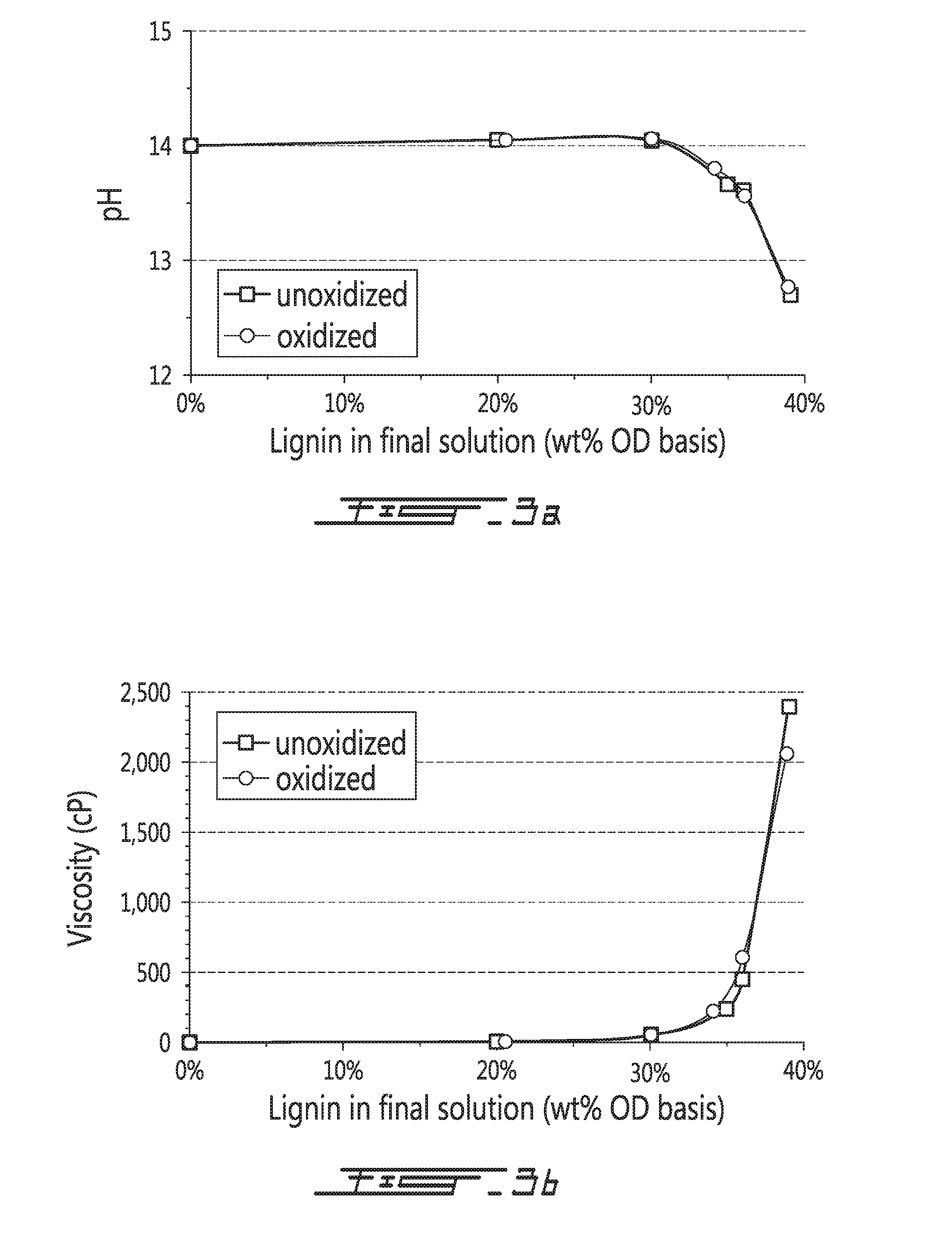High residual content (HRC) kraft/soda lignin as an ingredient in wood adhesives
a residual content, wood adhesive technology, applied in the direction of lignin adhesives, adhesive types, adhesive types, etc., can solve the problems of not being able to discharge directly to the receiving water and/or the mill effluent treatment system, the use of kraft/soda lignin as a dust suppressant on dirt roads or other applications is no longer practicable or greatly diminished, and the resin manufacturer is not equipped to handle powdered materials
- Summary
- Abstract
- Description
- Claims
- Application Information
AI Technical Summary
Benefits of technology
Problems solved by technology
Method used
Image
Examples
example 1
Evaluation of Conventional LRC Lignin as a Replacement of PF Resin in Softwood Plywood Glue Mix
[0097]An aqueous solution of 10% NaOH was prepared. The solution was mixed until it became completely homogeneous. The lignin used in this experiment was produced using a conventional process in which the black liquor was not oxidized. Lignin was produced from this 30% solids liquor by:[0098]a) Acidifying the black liquor with carbon dioxide to a pH of about 10 to induce the lignin to come out of solution in the form of colloidal particles[0099]b) Allowing time for the lignin particles to coagulate to larger particles[0100]c) Filtering the lignin suspension to remove the residual black liquor[0101]d) Washing the lignin cake with sulphuric acid and water to produce a purified lignin in the acid form (LRC lignin).
[0102]Four different mixtures of LRC lignin in 10 wt % NaOH were then prepared. The lignin concentrations were 10, 15, 20 and 25 wt %. The solutions were mixed until complete disper...
example 2
Substitution of 30 wt % of Commercial Phenol-Formaldehyde (PF) Resin with HRC Softwood LignoForce™ Lignin in Bonding High-Density Wood (Yellow Birch)
[0120]The lignin used in this experiment was produced from 30 wt % solids softwood black liquor using the LignoForce™ process (Kouisni and Paleologou, U.S. Pat. No. 8,771,464 B2, Jul. 8, 2014) as follows:[0121]a) The black liquor was oxidized using oxygen beyond the point at which at least 95% of TRS compounds are oxidized[0122]b) The oxidized black liquor of step a) was acidified with carbon dioxide to a pH of about 10 to induce the lignin to come out of solution in the form of colloidal particles[0123]c) The lignin slurry of step b) was allowed to stand for about 60 min for the lignin particles to coagulate to larger particles[0124]d) The lignin slurry of step c) was filtered using a filter press to remove the residual black liquor to produce HRC lignin at 50-60 wt % solids[0125]e) The HRC lignin of step d) was used as needed.
[0126]In...
example 3
Substitution of 50 wt % of Fillers (Corncob and Superbond) in Softwood Plywood Glue Mix with HRC Softwood LignoForce™ Lignin—Mill Trial 1
[0130]In this mill trial, 50 wt % of fillers (corncob and Superbond) were substituted with softwood LignoForce™ HRC lignin. This lignin was prepared as discussed in Example 2. In this case, the content of the two fillers in the phenolic glue mix was 6.5 wt. % on a solids basis—hence, the content of lignin in the phenolic glue mix was 3.25 wt. %.
[0131]The HRC lignin was first dissolved in water at a concentration of 17 wt. %, and the lignin solution was mixed in the glue mix at a later stage during the glue mix production process. Douglas fir veneers of ⅛″ thickness were used for plywood production. A total of 70 4 ft×8 ft three-ply plywood panels were produced. The panels were hot-stacked before cutting and shipping to the lab for testing. The parameters for plywood production in the mill trial are summarized in Table 11.
TABLE 11Parameters for plyw...
PUM
| Property | Measurement | Unit |
|---|---|---|
| Temperature | aaaaa | aaaaa |
| Temperature | aaaaa | aaaaa |
| Temperature | aaaaa | aaaaa |
Abstract
Description
Claims
Application Information
 Login to View More
Login to View More - R&D
- Intellectual Property
- Life Sciences
- Materials
- Tech Scout
- Unparalleled Data Quality
- Higher Quality Content
- 60% Fewer Hallucinations
Browse by: Latest US Patents, China's latest patents, Technical Efficacy Thesaurus, Application Domain, Technology Topic, Popular Technical Reports.
© 2025 PatSnap. All rights reserved.Legal|Privacy policy|Modern Slavery Act Transparency Statement|Sitemap|About US| Contact US: help@patsnap.com



